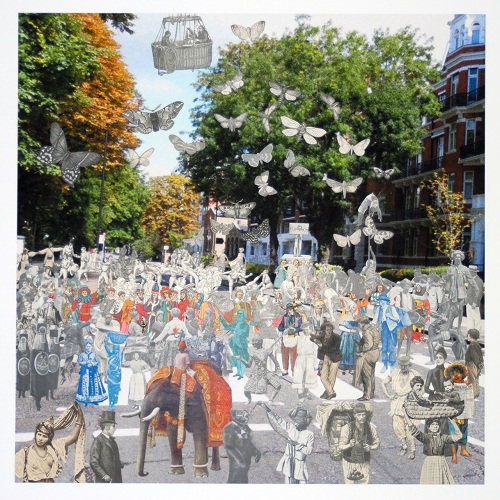
Peter Blake. “Abbey Road Parade” from the “London Suite,” 2012. Color screenprint on 410gsm Somerset Tub Sized paper. Image: 19 5/8 x 19 5/8 in. (50 x 50 cm); sheet: 26 1/4 x 25 5/8 in. (66.6. x 65.2 cm). Edition of 100, published by Paul Stolper Gallery, London. Image courtesy International Fine Print Dealers Association, New York.
[Ed. note: Some of the dates and events of the IFPDA print fair were rescheduled due to effects of post-tropical superstorm Sandy. See here for details: https://www.ifpda.org/content/. The E|AB Fair was initially canceled but has been rescheduled for January 23-27, 2013, in a new location: The Altman Building, 135 West 18th Street, New York, between 6th and 7th Aves. For further detail, see https://www.eabfair.com/]
One week per year, around the beginning of November, New York becomes editions heaven. The faithful (curators, collectors, professors, artists, critics, printers, publishers, dealers, scholars, and students) and the curious throng to the city to revel in a sea of riches and learn what’s new in the field. Publishers and dealers from all over the world, as well as auction houses around the city, proffer prints and multiples of every medium, size, shape, rarity, historical period, cultural tradition, and budget. Galleries, museums, and exhibition spaces organize outstanding exhibitions in the medium. Receptions, breakfasts, and parties are thrown. Events and talks range from the serious to the wacky – milestones in scholarship are celebrated, trends are analyzed, recent publishing projects are discussed by artists and printers, techniques are demonstrated, and this year, you can even get your hair cut in classic punk style.
Festivities begin the week of October 29 – a complete list of events is available on the website of the International Fine Print Dealers Association, which also organizes the week’s founding event, the IFPDA Print Fair at the Armory on 67th and Park Avenue – admission is ticketed (with a variety of options). The IFPDA fair’s counterpart is the Editions|Artists’ Books Fair, which celebrates its 15thAnniversary this year and takes place at the Former Dia/X Initiative Building on 22nd near 11th Avenue – admission is free (with the exception of $25 for opening night). While there are numerous auctions and exhibitions around the city, these two fairs serve as the respective centers of gravity events during New York Print Week. The IFPDA Print Fair kicks off on October 31 with an Opening Night Preview from 6:30 to 9 while the E|AB Fair’s Opening Night Party will take place the following evening from 6 to 9. In addition to being the places to see and be seen, both events are fundraising opportunities for the organizations themselves: a $50 donation to the IFPDA Foundation is built in to the ticket price of $75 for the former; a limited edition print by Dana Schutz (whose recent monotypes were discussed in the April issue of this column), printed at Prints of Darkness and published by I.C. Editions, Inc., will be available for purchase at the E|AB fair’s opening night for $250 – sales allow admission to remain free and open to the public.
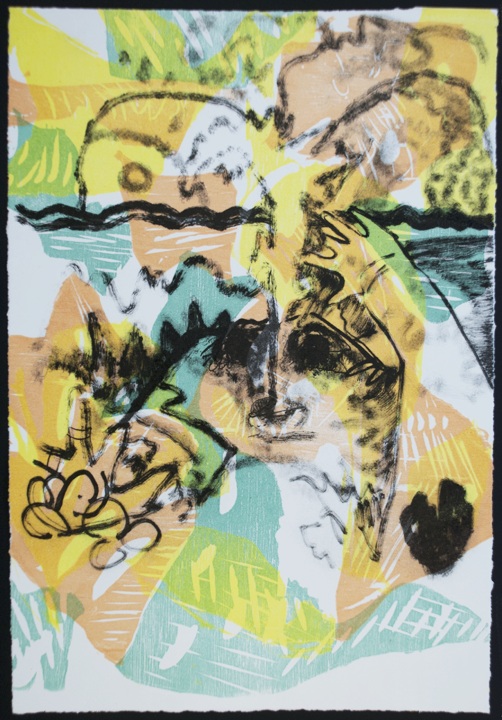
Dana Schutz. “Backstroke,” 2012. Three-color woodblock with one color photo-litho on Coventry paper, 17 3/4 x 12 ¼ in. (45 x 31 cm). Edition of 200, published by I.C. Editions, Inc. to benefit the Editions | Artists’ Book Fair, NYC, 1-4 November. Image courtesy Susan Inglett Gallery/I.C. Editions, Inc., New York.
IFPDA exhibitors (90 this year) tend to bring their newest, finest, or rarest works to the fair. Notable rarities this year include an early lithograph by sculptor Richard Hunt at Aaron Galleries (illustrated below) and a 1916 portfolio of hand-colored linoleum cuts in an edition of 5 produced at the Wiener Werkstätte at Galerie St. Etienne. Old Master dealers are certain to have a number of lovely and rare impressions in a range of prices by Italian, Dutch, French, and German artists, while Japanese Ukiyo-e dealers’ booths will sparkle in brilliant color with fresh and vibrant woodblock prints from that tradition. American Modern prints by major players, like George Bellows and Elizabeth Catlett, will be alongside lesser-known gems by the likes of Letterio Calapai and Edmund Blampied. For Modern and Contemporary lovers, there are sure to be copious examples by blue-chip artists, such as Munch, Picasso, Miro, Baldessari, Close, and Warhol, but also a wide range of mid-tier, under-represented, and emerging artists.
New editions by hot names like Nicole Eisenman, Trenton Doyle Hancock, Laura Owens, and Damien Hirst will be tempered by offerings from lesser-known contemporary artists, hailing from not only Europe and the United States, but also Brazil, Bulgaria, and Cuba. As discussed by IFPDA Executive Director Michele Senecal, exhibitors are selected by the board, an elected body of members who feel “it is extremely important to ensure that the fair is accessible to as many as possible…it is essential to offer prints not only of the highest caliber and rarity, but also those that allow newer collectors an entry-level price point. We want everyone to feel that they can walk out the door with a work of art.” Visitors to the fair will find works priced anywhere from $150 to $1,500,000 plus, and all exhibitors are required to post this information either directly adjacent to the work or in a list that is readily accessible in their booth.
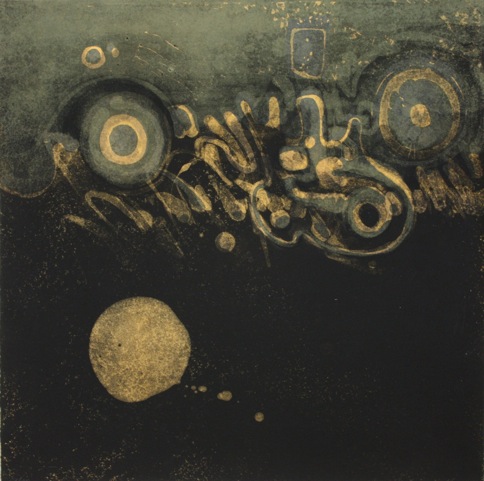
Richard Hunt. “Untitled Abstract,” ca. 1965. Lithograph in colors. 18 x 18 in. (45.7 x 45.7 cm). Artist’s proof, published by Tamarind Lithography Workshop, Los Angeles (now Tamarind Institute, Albuquerque, NM). Image courtesy International Fine Print Dealers Association, New York.
The E|AB Fair presents only recent and new projects, with an eye to “encouraging people to think outside of the box about what prints and editions might be,” as explained by organizer Susan Inglett of I.C. Editions, Inc. Participants (over 60 this year) also include galleries and publishers, in addition to non-profit organizations, artist collectives, and workshops who will offer everything from affordably-priced letterpress books, coasters, digital editions, ceramic honey bears, koozies, ‘zines, and photo books to higher-priced limited-edition prints, portfolios, and books by important contemporary artists. In addition to its innovative ethos, the primary strength of this fair is it allows a glimpse into art subcultures throughout the world, such as India, South Africa, Canada, France, and Holland – but also here in the U.S., with representation of upstart publishers based in Brooklyn, the Hudson Valley, Philadelphia, Providence, Boston, Connecticut, Chicago, Saint Louis, Minneapolis, Portland, Seattle, and Los Angeles, among others.
Each of the fairs also hosts various programs and events throughout the week that characterize its spirit. The IFPDA fair offers educational curator-led tours and informative panel discussions with distinguished scholars, curators, and artists, while the E|AB fair serves up a wide variety of DIY/performance events, including the Punk Cult Club event organized by Amsterdam’s artKitchen gallery and Luiscius Books, which will include a hair salon that will produce an unlimited edition of mohawks (naturally). Kayrock Screenprinting will edition an “Invisible Corps” or “Exquisite Corpse” collaborative print that can be purchased when complete; Dennis McNett will perform an event (sure to be raucous) with his signature oversized print-based objects; Esther K. Smith of Purgatory Pie Press will host a make-your-own book workshop; and The Long Life China Company, a porcelain multiples publisher founded by Cammi Climaco, will mold and form ceramic art on site. There will also be notable events at non-profit spaces outside of the fairs, including an evening opening reception on October 30 and breakfast with the artists on November 3 for New Prints/Autumn at IPCNY, and an evening talk on November 2 with artist Lesley Dill and poet Tom Sleigh at Dieu Donné Papermill.
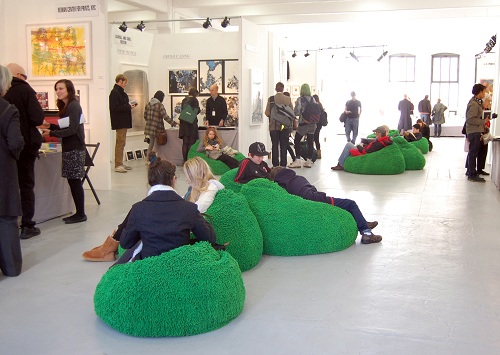
Visitors relaxing in the E|AB lounge. Image courtesy Susan Inglett Gallery/I.C. Editions, Inc., New York.
As previously mentioned, this year marks the 15th Anniversary of the E|AB fair, a milestone that prompts consideration about how this week of print saturnalia began and how it has evolved over the years. The precursor to the IFPDA fair was the New York Fine Print Fair, also held in early November at the Armory, which was founded by the dealer and scholar Jeannot R. Barr in 1984. The timing for the fair was likely prompted by the well-established fall auction season and the two remain concurrent: this year, Phillips de Pury, Christie’s, Swann, and Sotheby’s hold their sales of prints/editions/multiples in quick succession beginning October 29 (an overview can be downloaded here, published in this month’s Art + Auction). After the IFPDA was founded in 1987, many of the fair’s exhibitors became members, and in 1991 the organization assumed responsibility for the event. The E|AB fair was founded in 1998, primarily in response to the overwhelmingly historical material then offered at the IFPDA fair. Inglett relates a story in which a client of hers came to her gallery in 1997 (located in SoHo at that time), fresh from the IFPDA fair. She asked him about it and he said the fair was great, but he was disappointed that there were no new editions and left with the impression that “no one is publishing prints anymore.” Knowing this was not the case, Inglett approached fellow publishers Brooke Alexander and Printed Matter about organizing a fair of exclusively new editions to coincide with the IFPDA fair the following year and the galleries – at that time, all located on Wooster Street – served as venues for twenty exhibitors in the inaugural Fair.
Over the past decade, the two fairs have expanded and evolved along with the greater phenomenon of art fairs in general. The IFPDA fair – either in response to the overwhelming success of the E|AB fair or changes in public taste (or both) – has markedly increased representation of contemporary prints and editions, which are now plentiful. Additional recent changes include a more open floor plan with a central lounge area and passages between the aisles, corporate sponsorship, a Collectors & Curators Breakfast, and a book award, which was established in 2004 to “encourage research, scholarship and the discussion of new ideas in the field of fine prints.” For many years, proceeds from the opening night supported acquisitions for the Museum of Modern Art’s department of Prints and Illustrated Books, but this changed in 2010 with the establishment of the IFPDA Foundation, a charitable arm of the organization with a separate elected board that issues grants to nonprofit museums, galleries, organizations, and publications in support of educational initiatives in prints. Though the IFPDA had always issued such grants, a need was felt to separate this activity from the educational efforts of the IFPDA itself, which encourage print connoisseurship. It also allowed additional funds to be channeled into the grant program, resulting in a newly-established acquisition prize this year, sponsored by Champion & Partners in honor of Richard Hamilton, which will award $10,000 for the museum purchase of a new work at the fair; the winning institution (selected by the board of the IFPDA Foundation) will be announced on opening night. Also new this year is an online catalogue of highlights and a mobile website that will allow visitors to search offerings by category, artist, or exhibitor with their smartphones (visit www.printfair.com with your device).
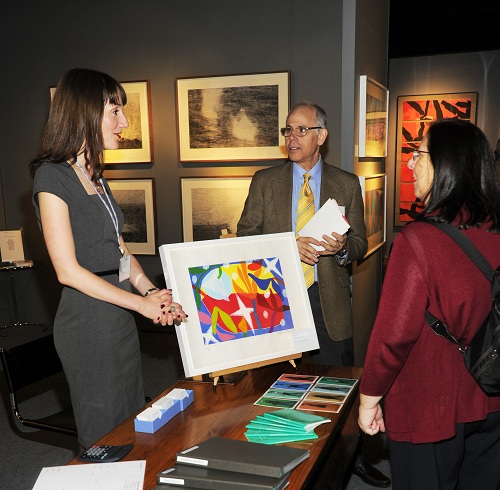
Attendees of the IFPDA Print Fair chatting with a dealer. Photocredit: © Patrick McMullan/PatrickMcMullan.com. Image courtesy International Fine Print Dealers Association, New York.
For its part, the E|AB fair has grown in size since its early years, adding an additional venue at Deitch Projects in 2001 before relocating to Chelsea (along with most of the rest of the New York gallery scene): first the Starrett-Lehigh Building, then The Tunnel, and then to the Former Dia/X Initiative Building in 2009. The three original organizing publishers continued to work together for a number of years, but Printed Matter peeled off to found the New York Art Book Fair in 2006, and Brooke Alexander bowed out after 2010 (now exhibiting at the IFPDA fair). Venue changes have been prompted by increased interest from both the public and publishers. Inglett is always on the lookout for publishers who are “thinking innovatively about how to approach the medium” and who can “bring new energy to the floor,” and new exhibitors are introduced every year. Throughout the changes, Inglett says the fair has maintained its grassroots origins and an “all for one and one for all spirit” – it has always been run as a break-even operation and it is important to those involved that admission remains free. Events, which are solicited from participants, allow exhibitors “a chance to show off their stuff” and have been an important aspect of the fair for years. This year marks a heightened commitment to such happenings, with an half of the fourth floor dedicated to carousing, art-making, and the aforementioned haircuts.
As noted in a recent article in Art in Print, (“New York Print Week 2012,” vol. 2, no. 3: 45) much has been made of a supposed rivalry and upstairs/downstairs dynamic between these sister fairs in the past, but “it is all nonsense of course: both fairs are chock-a-block with treasures; anyone with a serious interest in prints feels lucky to spend hours in each location; and many exhibitors alternate between the two.” Together, they provide a nearly comprehensive overview of the history of prints and editions, offer opportunities to view and even purchase rare works of art, and inject new energy into the print world – a spectacle not to be missed.




Pingback: An Interview With Leela Corman | Art21 Blog